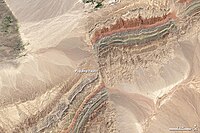
Photo from wikipedia
Abstract Buried pipelines crossing reverse faults is a common case in practice, while their mechanical responses are not very clear. To analyze buried pipelines subjected to reverse faults, a beam-shell… Click to show full abstract
Abstract Buried pipelines crossing reverse faults is a common case in practice, while their mechanical responses are not very clear. To analyze buried pipelines subjected to reverse faults, a beam-shell coupling scheme is proposed based on the Vector Form Intrinsic Finite Element (VFIFE or V-5) method. Particular emphasis is given to identifying pipeline failure with three performance based limit states: the local buckling, the tensile strain limit and the flattening parameter limit. The critical fault displacements, at which the specified performance criteria are reached, are presented in diagram form. Effects of fault displacement, crossing angle, as well as fault dip angle on critical fault displacements are examined. This study shows that when the fault dip angle is 40°, the critical fault displacements of local buckling and pipe-wall rupture are the largest when a pipeline is oriented approximately parallel to a reverse fault plane. And for a perpendicularly crossing pipeline, the smaller the dip angle is, the more severe the cross-section distortion will be. Moreover, the critical strain of local buckling are obtained and compared with the recommendation of CSA Z662.
Journal Title: Soil Dynamics and Earthquake Engineering
Year Published: 2017
Link to full text (if available)
Share on Social Media: Sign Up to like & get
recommendations!